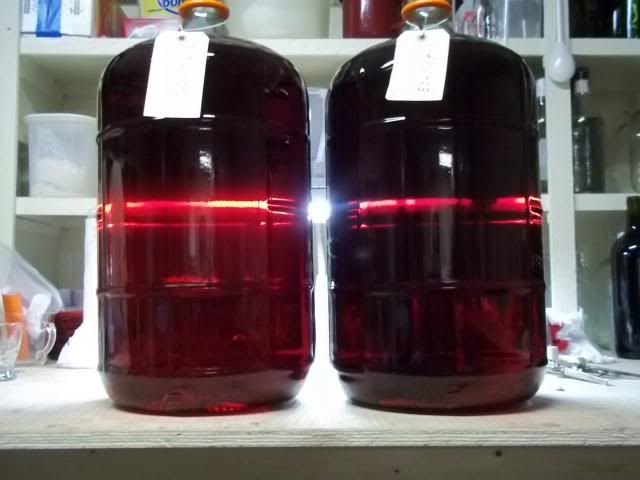dangerdave
Chief Bottlewasher
- Joined
- Jul 13, 2011
- Messages
- 2,729
- Reaction score
- 901





Time for an update! And what an update it is! Stow all of your preconceptions about the outcome of this test and read on...
The Dragon Bloods are both clear, so I racked them off the sediment a few days ago and sat them infront of my light to compare their color. The picture below does not lie. The wine on the right is definately darker, richer in color! I know you can't read the tags, but try to guess which is which before you read below.

First, I'll tell you all what I discovered, then I'll give you my opinion as to why. But before that, let me again emphasize that I did everything in my power to make these wines side-by-side, exactly the same. Since we all make wines, we understand that certain conditions are beyond our control. For example, I cannot confirm that the exact amount of each fruit (blackberry/blueberry/raspberry) was preasant in each batch. One batch could very well be darker because of the quality or quantity of a particualar fruit in the batch. I did all I could to make this a fair and useable comaprision. Enough about that, though.
Read on...Note: At this point, neither wine has been sweetened.
That's the 71B on the left, and the EC on the right. Aside from the color variation, there was more. I poured a small amount of each wine into two small glasses. Not stating which was which, I presented them to my wife. She's my "second opinion". In this case, she nailed my own observations precisely, without prompting.
COLOR: As far as color goes, you've seen the picture above. The EC produced a wine of deeper color. It showed in the glasses, too. The 71B just looked thinner. At the point where the wine met the glass, the EC version held it's color, and clung more readily to the side than the 71B. The EC produced the characteristic ruby red color I have come to associate with the DB, while the 71B gave the impression of a more subtle blush---like White Zin, my wife said. I agreed.
AROMA: At this point, things became more similar. The 71B produced a nice fruity aroma, with no hint of acid in the nose. Again, very subtle, and very pleasant. The 71B had done it's work! Then came the EC. It had a distinctive scent of fruit and fresh lemon. Much closer to what one would expect from fruit that is both sweet and tart at the same time. Both were very nice to the nose. A plus on both accounts.
TASTE: Then we came down to it. For me, the flavor is everything. The 71B turned out to be very light, with virtually none of the acid "tang" I have come to associate with the my beloved DB. This yeast had most definately worked on the acids during primary fermentation, producing a light fruity wine, easy on the tongue, with a flavor that vanished quickly after tasting. If you like a nice, glossy, white zin with good fruit flavor and no bite, then this is the one for you. On the other hand, the EC produced a wine with more body, bolder character, with a bit of "zing". The acidity was right there with the fruit, declairing the lemon as equal to the rest. It stayed on the tongue longer and produced a lingering after-taste that made me want to snack my lips.
My thoughts: For me (and my wife), this was a no brainer. The EC-1118 produced as it always had; the DB that we have always enjoyed. While not as strong---acidly---as Lon's original Skeeter Pee, the balance it produced in the particular wine was spot-on. Was the 71B-1122 an improvement? Not in my opinion. However, if you find yourself drinking your DB and wishing it was lighter and less acidic, then the 71B might be your answer. But if you are like me, and want your DB with a bit of a tart bite, and a fuller body, then stick with the EC-1118.
Why? As the 71B-1122 is described, it works to recude the acidity in wines where the fruit being used (such as blackberry) has a higher Ph. These acids, I am convinced, are what give the DB it's distinctive color and flavor, working---along with the yeast---to draw more tannins and color from the skins, pulp, and seeds of the fruit. Remove or reduce these acids (as in the action of the 71B), and you reduce this desireable action, producing a paler, smoother, lighter wine. The EC-1118, being the "work horse" of yeasts, thrives in this kind of enviroment; a fact, no doubt, known to our illustrious inventer of the original SP recipe. My hat's off to Lon DePope!
I am still yet to sweeten these batches, but I hardly see where this will change the facts. My plan, if they maintian their individual charaters, is to blend the two batches prior to bottling. If I don't, my wife will ask my every time we open a bottle which one it is. She still wants the original DB, not a whole batch of sudo-white-zin.
I hope this simple study has helped the DB fan base, encouraging those who like the original, and giving hope to those who want a lighter version.
Peace out!

Last edited:







![[Upgraded] 9Pcs Tree Root Growing Box with Drain Holes, Half Transparent Plant Rooting Propagation Ball & Metal Core Twist Ties, for Fast Propagation Plants (Size M)](https://m.media-amazon.com/images/I/514MWQxtWOL._SL500_.jpg)














































